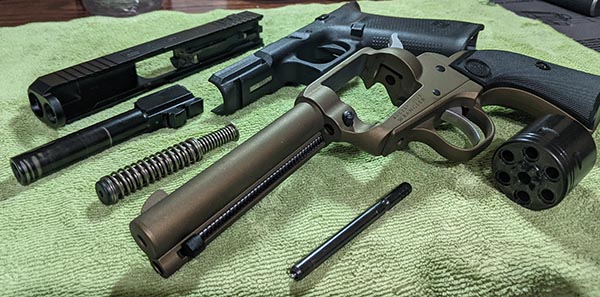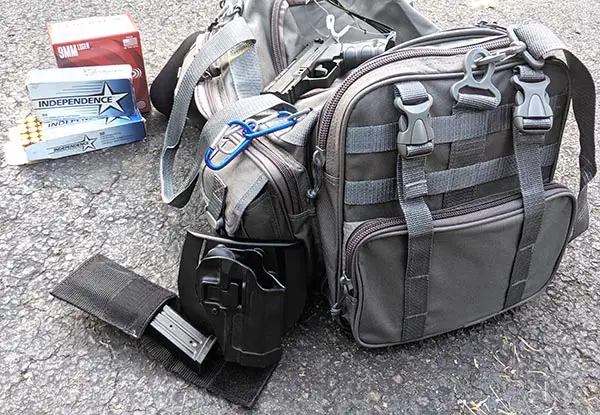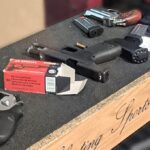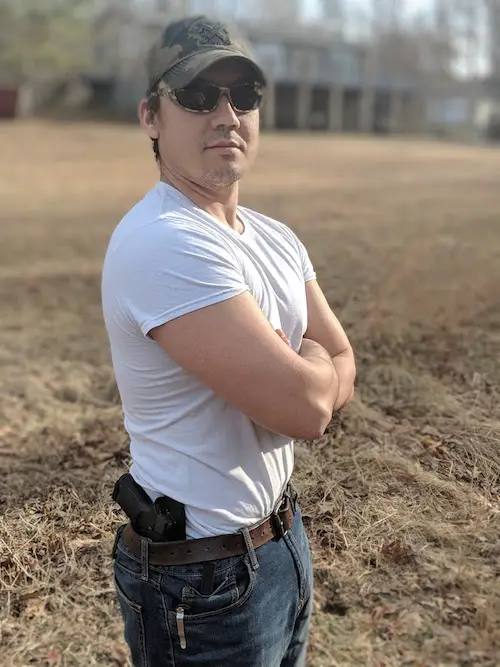If you’re going to own and shoot guns, you should know the basic parts of a handgun and how they operate. Understanding the operation of a pistol will help you diagnose malfunctions, maintain your firearm, and communicate intelligently about your gun. The 3 basic parts of a handgun are the frame, barrel, and action. However, each part may contain one or more smaller pieces and parts.
Additionally, one part can have multiple labels to define a different section of the part. By the end of the article you should have a thorough understanding of the name, function, and location of common pieces on both types of handguns (semi-autos and revolvers).
Table of Contents
The Basic Parts Of Any Handgun
Regardless of whether your handgun is a semi-auto or revolver, the basic parts — frame, barrel, and action — are the same. The frame is essentially the body of the firearm and houses the various parts that make the gun operate. Next, the barrel is the metal tube that a bullet travels down once fired. Finally, the action represents the moving parts that control the cycle of operation.
Although the parts are the same, they look and operate differently on a revolver when compared to a semi-auto. Don’t worry I’ll cover that in more detail below.
Labeled Parts Of A Handgun
Images labeling the basic parts of each handgun by type are below. First, I’ve labeled internal and externally visible parts for a semi-auto handgun. Additionally, I’ve provided the list of parts on a single action revolver. Finally, I note the parts and differences of a double action revolver.
If you are unfamiliar with the labels, don’t worry. I cover each of them in the sections that follow. However, I wanted to provide a visual aid for learning the handgun parts.
Parts of A Semi-Auto (a.k.a. Autoloader a.k.a. Automatic)
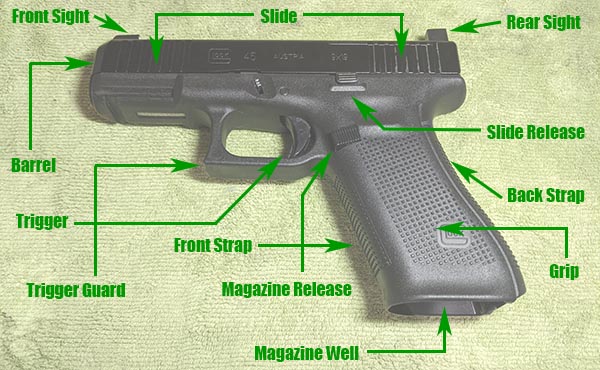
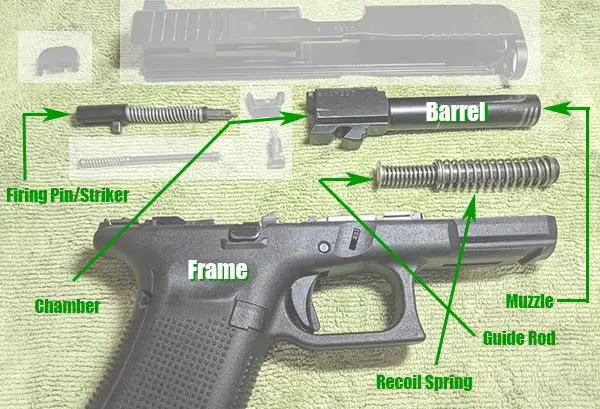
Parts Specific to Semi-Auto Pistols
- Recoil Spring – The part of a pistol that transfers energy into the slide allowing it to move laterally. Additionally, the slide activates during the cycle of operation to maneuver the slide allowing a case to be ejected, a new round to chamber, and return the slide to battery.
- Guide Rod – Keeps the movement of the recoil spring/slide on plane and limits the travel range of the recoil spring. A captured guide rod will contain both the recoil spring and guide rod in one unit. The above illustration shows a captured guide rod.
- Slide – The slide is the part of a pistol that moves laterally to expose the chamber. Thus allowing a spent case to eject and a new cartridge to enter the chamber.
- Slide Release (a.k.a Slide Stop) – When engaged the slide release locks the slide rearward exposing the chamber. The slide release should automatically engage when a magazine is empty and no round can be chambered. Disengaging the slide release allows the slide to travel forward back into battery.
- Extractor – This part extracts the spent case from inside the chamber before ejecting, which allows a new cartridge to be loaded.
Parts of A Single Action Revolver
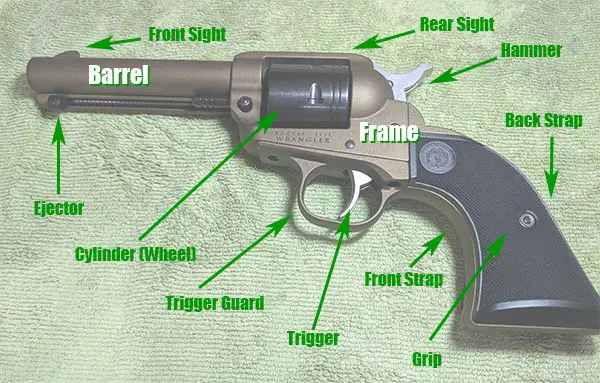
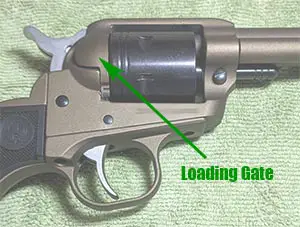
Unique Parts On A Single-Action Revolver
- Loading Gate – This part of a single-action revolver folds open to expose a single chamber within the cylinder allowing a case to be ejected and/or a cartridge to be loaded.
- Ejector Rod (a.k.a Ejector) – The ejector rod is a spring loaded rod that manually retracts to eject a spent case or live cartridge from a single chamber in the cylinder.
Parts Of A Double Action Revolver
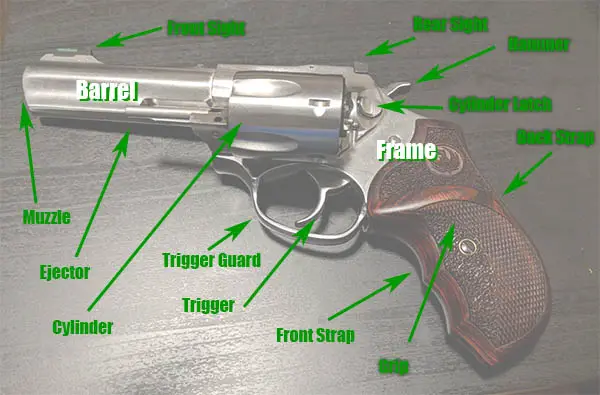
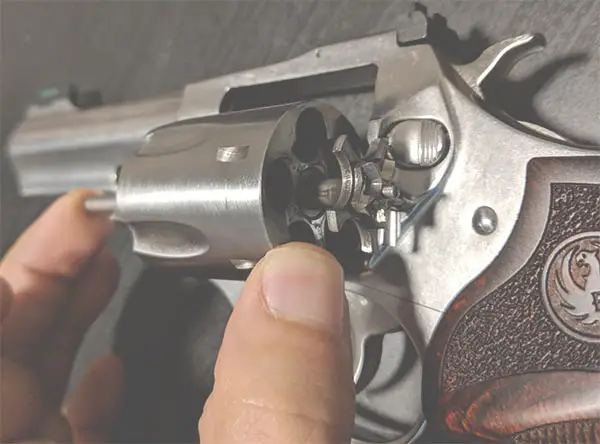
Parts Unique To A Double-Action Revolver
- Cylinder Latch – The cylinder latch is the part of a double-action revolver that allows the cylinder to slide laterally from within the frame and exposes all chambers.
- Ejector Rod – Unlike the ejector rod on a single-action revolver, the double-action ejector rod empties all chambers within the cylinder simultaneously.
Dissecting The Frame
The most notable part of the handgun frame is the grip, or the part where you hold the handgun. Furthermore, two sections comprise the grip; the front strap and back strap.
First, the front part of the grip is called the front strap. Your index through pinky finger grip the front strap. Second, your thumb wraps around the grip on the back strap. Some handgun models have interchangeable back straps to allow shooters to modify the grip to their liking.
Another part of the frame is the trigger guard, and is usually a circular or rectangular outline where the trigger will actually protrude through the frame. Although most firearms have a trigger guard, not all firearms do.
Parts Of The Barrel
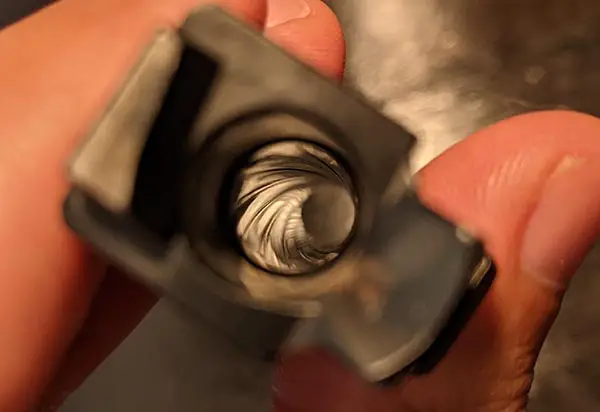
Similar to the frame, the barrel is pretty straightforward. However, there are several terms to describe the features of a barrel. Next, I’ll define the various parts that comprise the barrel found on a pistol. The bore is the inside of the barrel.
- Bore – The bore is used when describing the entire internal structure of the barrel.
- Rifling – A combination of lands and grooves within the bore. Additionally, rifling is shaped into a spiral pattern. Furthermore, the spiral pattern places a rotational spin on the bullet allowing a straight flight pattern and maximum travel distance.
- Lands – Raised portions of the rifling. If you’re looking for a mnemonic, think of an island which sticks up out of the water.
- Grooves – Lowered portions of the rifling that work in conjunction with the lands to create the rifling.
- Breech – Universally used to describe the rear of the barrel. However, on a semi-auto pistol the breech end is actually at the rear of the chamber.
- Muzzle – The muzzle is the front-most part of the barrel and is where the bullet actually exists the gun when a cartridge is fired.
Definition & Basic Parts Of The Action
Finally, the most complex part of the handgun is the action. Various different parts make up the action including the trigger, hammer, slide/wheel, and more. A good way to define the action is any part of the handgun that moves during the normal cycle of operation.
Each handgun is different, so some portions of the action will not be present on every handgun. Below is a list of common parts often associated with the action. You can view the locations and/or visual representation of these in the labeled parts section above.
- Trigger – Initiates the firing of a cartridge by releasing the hammer or activating the striker/firing pin.
- Hammer – Can be found on semi-auto and revolvers. Has an integrated firing pin or strikes the firing pin to discharge a round
- Firing Pin – Part of the handgun that actually contacts the primer on a cartridge. Additionally, this part may be integrated into the hammer on some handguns.
- Sear – On a pistol, the sear holds the hammer or striker back until adequate pressure is applied to the trigger.
If you are unfamiliar with any of the terms in the preceding sections, I highly recommend reviewing the concealed carry test article. Each term is clearly defined there. Additionally, it may provide further clarification on the parts of a handgun with additional graphics and definitions.
So, What Holds The Bullets?
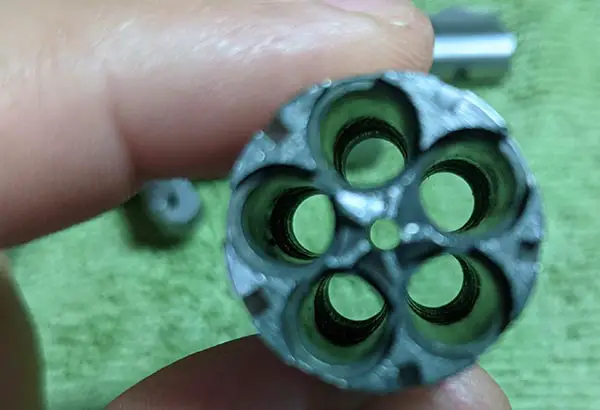
Usually when people ask about “bullets” they’re actually referring to the cartridges. And you’ll notice I didn’t really speak about that in great detail above. That’s because where the cartridges are held varies by type of pistol.
On a semi-auto handgun the magazine holds the cartridges. Whereas, on a revolver ammunition is housed inside separate chambers within the cylinder. In order to clarify, let’s cover the parts of a handgun associated with loading and unloading.
- Chamber – Can only hold one round of ammunition at a time that is set to be fired. Integrated into the rear of the barrel on semi-auto handguns.
- Cylinder a.k.a. The Wheel – A rotating cylinder containing individual chambers and found exclusively on revolvers.
- Magazine – Part found exclusively on semi-auto pistols that holds excess ammunition.
- Magazine Well – A hollow opening that is usually integrated into the grip/frame on a semi-auto. Additionally, the magazine well holds the magazine in place to allow fresh cartridges to enter the chamber.
- Magazine Release – When the magazine release is depressed it allows the magazine to be removed from the magazine well.
I highly recommend reviewing my concealed carry test preparation article if any of the terms used in the definition are confusing.
Parts of A Pistol Magazine
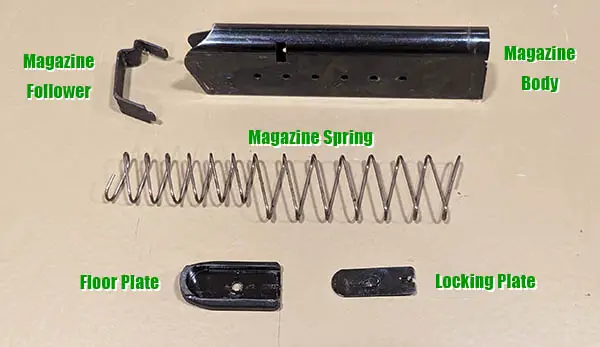
Magazines are pretty simple mechanical devices that house the cartridges on semi-auto pistols. Furthermore, only 5 pieces comprise this part of a pistol. Review the illustration above and compare to the definitions below of a better understanding of each part.
- Body – The body is the main housing for all other parts of the magazine. Additionally the magazine body is either double-stack or single-stack. A double-stack magazine body will stagger cartridges in a zig-zag pattern while a single-stack magazine body aligns cartridges directly on top of one another.
- Magazine Spring – The magazine spring is contained within the body of the magazine. Additionally, the tension from the spring pushes the follower upward
- Follower – The follower is the part of a pistol magazine that aligns cartridges in the correct orientation (single stack or double stack) inside the magazine body allowing cartridges to be loaded into the chamber during the cycle of operation.
- Floor Plate (a.k.a. base plate) – The floor plate is the base that the magazine spring rest on which creates tension on the follower.
- Locking Plate – This part prevents the floor plate from shifting and locks it into place at the base of the magazine body.
Other Parts of A Pistol
As you can see, the parts of a pistol vary between different handgun types (DA revolver, SA revolver, and semi-auto pistol). However, there are an abundance of differences even between different model handguns that are the same type. Alternatively, there are parts shared by pistols regardless of handgun type. Therefore, I’m compiling a list of other important parts of a pistol.
- Sights – Used to aim the handgun. Utilizes a front and rear sights to form proper sight alignment which is essential for optimal shot placement.
- Trigger Guard – As the name implies, this part of a pistol is designed to protect the trigger from unintentionally coming into contact with anything that might cause the gun to discharge.
- Safety – Any number of pistol parts designed to prevent a handgun from discharging accidentally. Additionally, the pistol safeties are both internal or external. Furthermore, safeties can either be passive or active.
- Slide Cover (a.k.a. Slide Cover Plate) – The slide cover is the part of a pistol that retains the internal components of the slide such as the striker, extractor plunger, among others.
- Decocking Lever (a.k.a. decocker) – Allows the hammer to lower without pulling the trigger and utilizes a firing pin block to prevent the handgun from discharging.
Parting Shots
Ultimately, trying to label every part on a handgun is extremely difficult because of variations on makes and models. However, hopefully this article has satisfied your curiosity about the basic parts of a handgun. I’ve tried to be thorough, but if you still have questions feel free to leave a comment. Alternatively, if you found this information insightful, please share with your network.
